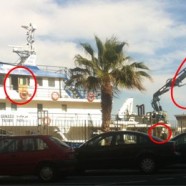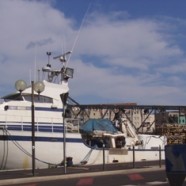Libya still Manages their Embassy in Sète
Despite the current conflict and the break in diplomatic relations between France and Libya, the city of Sète and its tourist heart continue to represent Libya, as always without problem, the regime of the famous colonel. Ten tuna fishing boats proudly claiming their homeport and their administrative and financial connections with Tripoli adorn the streets and terraces of the cafés. The riverboats in Sète departing the old city’s bridge leave to the right a part of the Libyan fleet while declaiming through a megaphone, “Since forever the tuna fishing boats of Sète fish for bluefin tuna exclusively in the Mediterranean.”
The radioactive contamination of fish
The French and European authorities don’t appear to have grasped all the difficulties raised by the control of fish and other seafood products likely to have been contaminated by atmospheric deposits and liquid radioactive matter in the coastal and deep sea regions of the North West Pacific. This is the most productive area in the world. It is exploited by fleets from Japan, China, South Korea, Taiwan and Russia. IUU fishing – illegal, non-declared and non-regulated – is very active here.
Global catches are approximately 20 million tonnes per year. Catches of Japanese anchovy and mackerel reach 1.5 million tonnes and 900 thousand tonnes per year respectively. Squid, cuttlefish and octopus catches are in the order of 1 million tonnes per year, and Japanese calamari and scallops are in the order of 1 million tonnes and 200 thousand tonnes per year respectively.
Bigeye Tuna is in the Red
Not the Same Old Tuna – #5
The International Commission for the Conservation of Atlantic Tunas and its adjacent seas – ICCAT.
17th -27th November Paris
The bigeye tuna in the Southern Atlantic grows quickly: 105 cm at 3 years old, 140 cm at 5 and 163 cm at 7. But it is disappearing even faster. The Gulf of Guinea houses the principle spawning ground, however the last assessment of bigeye tuna was taken in 2007, and the latest fishing figures date from 2005. Yet the contracted parties, notably the fishing states, were not in agreement over a project supported by the USA, the EU, and Japan, who would have imposed an onboard observer program and a 2 month suspension of all fishing activity. According to the Scientific Committee, “the bigeye tuna situation is worrisome.” The situation could deteriorate quickly with the movement of purse seine and longline vessels from the Indian Ocean to the Southern Atlantic over fear of piracy. Illegal fishing activity is suspected to be prevalent in this fishing ground and the total admissible catch for 2011 is set at 85,000 tons.
Where Are They Now?
Not the Same Old Tuna – #3
PA – 2, The International Commission for the Conservation of Atlantic Tunas and its adjacent seas – ICCAT.
17th -27th November Paris
During the Panel session number 2, responsible for the conservation of bluefin tuna, the fate of the ships announced as “removed” was often mentioned. The EU, for example, announced that 126 purse seine vessels and 130 longline vessels have been “removed” from the bluefin tuna fleet between 2008 and 2010, without giving precise information on the ships’ demolition, conversion or any other mode of decommissioning. Contracting parties from the Eastern Mediterranean also announced the “removal” of fishing boats and tugs assigned to transporting cages without providing detailed information on their demolition or their redeployment for another purpose.
ICCAT in its Lifeboat
Not the Same Old Tuna – #4
The International Commission for the Conservation of Atlantic Tunas and its adjacent seas – ICCAT.
17th -27th November Paris
In Paris, ICCAT contracting countries are multiplying good news announcements, positive resolutions and promises of finances to save tuna and to show the image of a united family and of world citizens.
However, the reality is the complete opposite. The declarations of catches, the statistics, the lists of ships involved, and the annual reports are, in general, truncated, manipulated, or nonexistent. Back payments of subscription accumulate. Absentees are given the benefit of the doubt, such as Algeria, suspected to be involved in illegal activities of bluefin tuna in 2008 and 2009 – the Algerian delegation arrived one day before the meeting finishes.
Robin des Bois Opening Statement
Not the Same Old Tuna – #2
Plenary, The International Commission for the Conservation of Atlantic Tunas and its adjacent seas – ICCAT.
17th -27th November Paris
This is the first time that Robin des Bois has participated as an observer at the ICCAT debates. We would like to thank the secretary of the Regional Fisheries Management Organization and its member states’ for their current efforts and those in the future to prevent the irreversible decline of tuna and tuna like species.
All tuna species merit equal, fair and efficient consideration and all professional fishers have the right to exercise their profession and their invaluable know-how in safe and social working conditions conforming to all international maritime regulations.
Japan sees red
Not the Same Old Tuna – #1
The International Commission for the Conservation of Atlantic Tunas and its adjacent seas – ICCAT.
17th -27th November Paris
Already in the first hours of the meeting, the Japanese showed their inflexibility on the origin and the traceability of bluefin tuna, of which they are the principal consumer world wide. The Japanese delegation tore into the system of tracking and controlling which was put in place by ICCAT and implemented by the fishing-states. The exporting countries were carefully put in the line of accusation. According to Japan, the fishing of bluefin tuna in the Mediterranean Sea is illegally done. Miraculously, all the tuna captured weigh between 31 and 32 kg; the minimum regulatory weight being 30 kg. Japan estimates that half of the bluefin tuna captured weigh less than 30 kg. It is interesting that the compilation of 17 B.C.D.s (Bluefin Catch Documents) show 5,258 tuna captured and put in fish farms during 6 months and 6,350 tuna released. From the Mediterranean catch to the fish market in Tokyo, the list of shady transactions and breaches in regulation is long.












